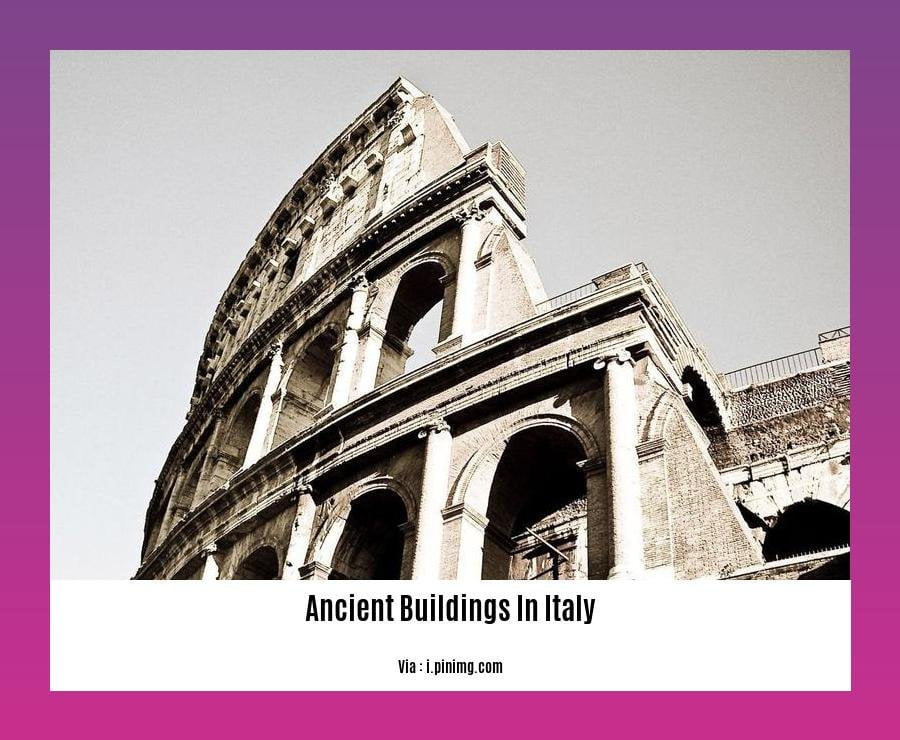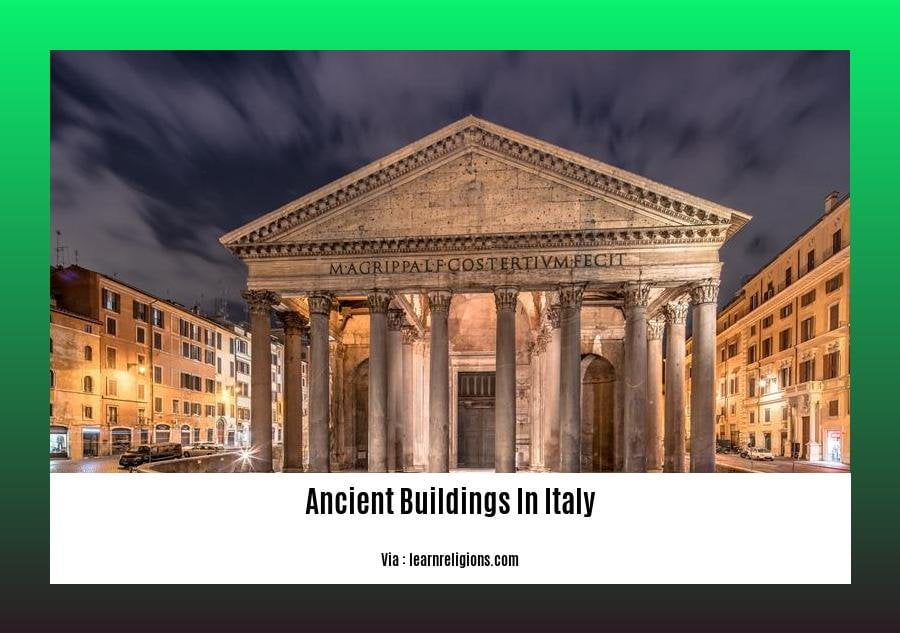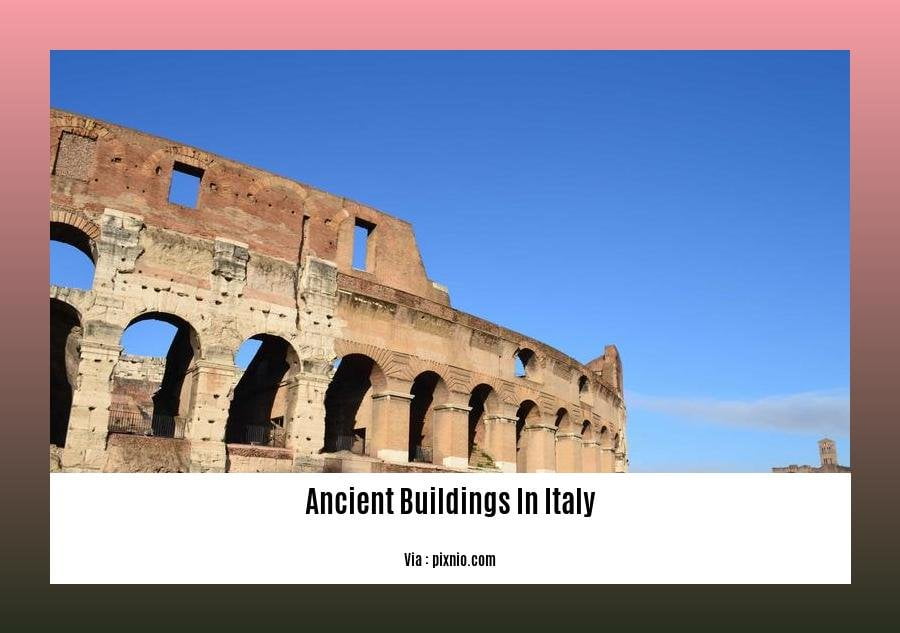Embark on a captivating journey through time as we unveil the splendor of ancient buildings in Italy, exploring their historical significance, architectural intricacies, and the dedicated efforts to preserve these timeless treasures. From the iconic Colosseum to hidden gems nestled in charming villages, Italy’s architectural heritage stands as a testament to human ingenuity, artistry, and cultural legacy. Join us as we delve into the captivating stories behind these ancient structures, uncovering the secrets of their enduring beauty and the ongoing efforts to safeguard their legacy for generations to come.
Key Takeaways:
- The Pantheon in Rome is exceptionally well-preserved, showcasing Roman architectural grandeur.
- Other significant ancient Roman structures include the Colosseum, Roman Forum, Herculaneum, Ostia Antica, Villa dei Quintili, Ara Pacis Museum, and Hadrian’s Villa.
- Italy saw the emergence of the Roman-Byzantine architectural style after the Justinian reconquest, characterized by elongated, rectangular buildings replete with mosaics and decorations.
- Roman influence is evident in the Christian basilica concept, featuring long, rectangular buildings adorned with mosaics and decorations.
Unveiling the Splendor: Exploring Ancient Buildings in Italy


Italy’s architectural heritage is a testament to its rich history and profound cultural impact. With roots in the ancient world, Italy’s landscape is dotted with awe-inspiring ancient buildings in Italy, each narrating tales of innovation, artistry, and societal progression. Embark on a journey through time as we unveil the architectural marvels that have stood the test of time.
H3: A Tapestry of Architectural Heritage
The ancient buildings in Italy reflect the diverse civilizations that have shaped the Italian peninsula. From the grand temples and theaters of the Romans to the intricate mosaics and soaring domes of Byzantine and Romanesque architecture, each era has left an indelible mark on Italy’s architectural landscape. Let’s delve into some notable examples that epitomize the architectural brilliance of ancient Italy.
H3: Colosseum: The Enduring Symbol of Roman Grandeur
Step into the majestic Colosseum, an iconic amphitheater that once hosted gladiatorial contests and public spectacles. Its imposing façade and intricate engineering showcase the Romans’ mastery of architecture and their passion for entertainment. The Colosseum stands as a symbol of Roman power and architectural prowess.
H3: Pantheon: A Timeless Ode to Architectural Harmony
The Pantheon, a marvel of engineering and aesthetics, stands as a testament to the Romans’ architectural ingenuity. Its vast, domed interior creates an awe-inspiring sense of space and harmony. The Pantheon’s architectural principles have influenced countless structures throughout history, solidifying its place as an architectural masterpiece.
H3: Pompeii: A Window into Ancient Roman Life
Buried under volcanic ash for centuries, the ruins of Pompeii offer a glimpse into the daily lives of ancient Romans. Its well-preserved streets, homes, and public spaces provide a fascinating insight into the urban planning, architecture, and art of the Roman Empire. Pompeii is an invaluable archaeological treasure that transports us back in time.
H3: Basilica of San Vitale: A Symphony of Byzantine Art
Located in Ravenna, the Basilica of San Vitale is a stunning example of Byzantine architecture. Its intricate mosaics, depicting biblical scenes and imperial figures, adorn the walls and ceilings, showcasing the exquisite artistry and religious devotion of the Byzantine era. The basilica’s octagonal shape and vibrant mosaics make it a true masterpiece of Byzantine art.
H3: Villa Adriana: A Glimpse into Imperial Luxury
The sprawling Villa Adriana, built by the Roman Emperor Hadrian, is a testament to the opulence and grandeur of ancient Roman villas. Set amidst lush gardens and adorned with exquisite statues and fountains, the villa served as a retreat for the emperor and his entourage. Its ruins offer a glimpse into the lavish lifestyle of ancient Roman rulers.
H3: Preserving Italy’s Architectural Treasures
The ancient buildings in Italy are not mere relics of the past; they are living testaments to the creativity, ingenuity, and resilience of ancient civilizations. Recognizing their immense cultural and historical significance, Italy has undertaken extensive efforts to preserve and restore these architectural wonders. Restoration projects, archaeological excavations, and educational initiatives ensure that these ancient buildings continue to inspire and educate future generations.
As we traverse the architectural landscape of ancient Italy, we are reminded of the enduring power of human creativity and the intricate tapestry of history that has shaped one of the world’s most culturally rich nations. These ancient buildings in Italy stand as symbols of a glorious past and a source of inspiration for generations to come.
Did you know that some ancient Chinese recipes are still enjoyed today? Learn more about it in ancient china recipes
Explore the fascinating ancient Chinese symbols and their meanings in ancient china symbols
Visit the unique historical sites of ancient cities in Israel and discover their stories in ancient cities in Israel
Preservation efforts
In Italy, the legacies of ancient architectural marvels stand tall, narrating tales of rich history and artistic brilliance. Let’s delve into the extraordinary efforts undertaken to preserve these treasures for future generations.
Key Takeaways:
- Italy boasts 58 UNESCO World Heritage Sites, a testament to its dedication to preserving its cultural and natural heritage.
- Restoration projects, archaeological excavations, and educational initiatives spearhead the preservation efforts, ensuring the survival of these iconic structures.
- International cooperation and partnerships bolster these endeavors, fostering expertise and resource sharing.
The Restoration Process: A Labor of Love
- Experts meticulously examine ancient buildings to understand their structural integrity and deterioration levels.
- Specialized techniques are employed to restore original materials and repair damaged components, maintaining the building’s authenticity.
- Artisans skilled in traditional crafts, such as stone carving and fresco restoration, play a crucial role in preserving intricate details.
- Modern technology aids in analyzing materials, monitoring environmental conditions, and documenting restoration progress.
Archaeological Excavations: Uncovering Hidden Histories
- Archaeological digs around ancient buildings reveal artifacts, foundations, and remnants of past civilizations.
- These excavations provide invaluable insights into the history, culture, and daily life of ancient societies.
- Unearthed treasures are studied, preserved, and often displayed in museums, enriching our understanding of Italy’s rich past.
Educational Initiatives: Nurturing the Next Generation
- Educational programs instill appreciation for ancient buildings and their significance among students and the general public.
- Workshops, guided tours, and interactive exhibits engage visitors, fostering a deeper connection with Italy’s cultural heritage.
- Universities and research institutions offer courses and programs dedicated to the study and preservation of ancient buildings, cultivating future experts in the field.
International Collaboration: Sharing Expertise and Resources
- Italy actively collaborates with international organizations, such as UNESCO and the World Monuments Fund, to share expertise and resources.
- Joint restoration projects and knowledge exchange programs promote the adoption of best practices in preservation.
- Partnerships with universities and cultural institutions facilitate research, documentation, and the dissemination of knowledge.
The preservation of ancient buildings in Italy is a testament to the nation’s profound respect for its architectural heritage. Through dedicated efforts, these timeless structures continue to inspire awe and provide a tangible link to the past.
Citation:
– UNESCO World Heritage Centre: https://whc.unesco.org/en/statesparties/it
– ScienceDirect:
FAQ
Q1: What makes ancient buildings in Italy historically significant?
A1: Ancient buildings in Italy hold immense historical significance as they offer a glimpse into the architectural prowess, engineering marvels, and artistic achievements of ancient civilizations, particularly the Romans and the Byzantines. These structures serve as testaments to the cultural, political, and religious influences that have shaped Italy’s rich history.
Q2: What are some of the unique architectural features of ancient buildings in Italy?
A2: Ancient buildings in Italy exhibit a diverse range of architectural features. From the Pantheon’s iconic dome to the Colosseum’s intricate arches, these structures showcase various techniques and styles. The use of materials like marble, stone, and mosaics adds to their aesthetic beauty and durability. Additionally, their designs often incorporated elements of Romanesque, Gothic, and Renaissance architecture.
Q3: How are ancient buildings in Italy being preserved and restored?
A3: Preserving and restoring ancient buildings in Italy is a complex and ongoing process. Experts employ meticulous techniques to maintain the authenticity and integrity of these structures. This includes using traditional materials and methods, conducting thorough research, and collaborating with skilled artisans and architects. Additionally, modern technology plays a role in monitoring and maintaining these buildings.
Q4: What are some of the challenges in preserving ancient buildings in Italy?
A4: Preserving ancient buildings in Italy poses several challenges. Factors such as natural disasters, pollution, and the passage of time can cause damage and deterioration. Furthermore, balancing the need for preservation with the demands of modern society can be a delicate task. Striking a balance between maintaining historical integrity and adapting these structures to contemporary uses is essential.
Q5: How can visitors appreciate and learn about ancient buildings in Italy?
A5: Visitors can appreciate and learn about ancient buildings in Italy through guided tours, museum exhibits, and educational programs. By exploring these structures in person or delving into their history and significance through various resources, visitors can gain a deeper understanding of the architectural legacy of Italy. Additionally, many ancient buildings are UNESCO World Heritage Sites, highlighting their global importance and encouraging international collaboration for their preservation.
















